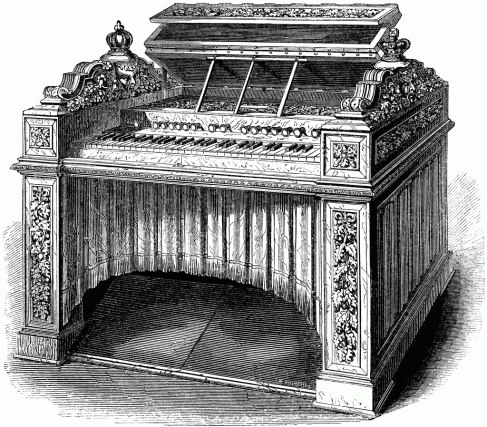by Eliza Waldman
The harmonium is an instrument largely unfamiliar to modern-day ears. It might surprise you to hear, however, that it was all the rage back in the 1800’s. Similar to the pipe organ, the harmonium is a keyboard instrument which uses bellows operated by the feet. Instead of pipes, though, the harmonium is driven by free reeds and is somewhat smaller than the conventional organs of the time.
While the harmonium’s true origins are unknown, the earliest Western free reed instruments are often linked to the Chinese sheng and other Eastern instruments which were imported to Europe sometime before the end of the 18th century. German professor Christian Kratzenstein and his associate Franz Kirschnik are generally credited as the originators of the Western free reed and are thought to have been influenced by the sheng, though recent studies have put such claims up for dispute. Kratzenstein was awarded the annual prize of the Imperial Academy of St. Petersburg in 1780 for his machine built with free reeds to study the usage of tones in speech. The free reed was subsequently taken up by organ builders and used in the making of instruments, but it was not till 1840 that the harmonium was patented by the Parisian native Alexandre Dubain.
The harmonium gained immediate popularity, largely due to its sophistication and increased convenience factor. It had a greater capacity for dynamic expression than the pipe organ, which made it popular with musicians. It also quickly gained a place in both amateur households and churches, where it was seen as a cheaper, smaller alternative to the organ. Composers were also fond of it; Liszt is known to have kept a harmonium for his personal use, and composers such as Camille Saint-Saens, César Franck, Arnold Schoenberg, Dmitri Shostakovich, and of course Giaochino Rossini all wrote for the harmonium. Arrangements and transcriptions of the works of Chopin, Strauss, and many others for harmonium remain, leaving the instrument with a wide and varied repertoire. It also found a place in ballet and even in the silent films of the times as an alternative to piano accompaniment.
The harmonium eventually spread to the United States, where an American version, called the reed organ or American organ, was first produced around 1860 by Mason & Hamlin. The American organ featured suction bellows instead of the European pressure system and produced a softer sound which appealed to the amateur audience. This model became prevalent in America and parts of Europe.
Sadly, the widespread success of the harmonium was short-lived. Around the turn of the century, changing views and tastes, as well as technological innovations, soon left the harmonium behind. It was seen as old-fashioned, with a certain air of kitsch to it. Musicians hunted for more modern sounds. In sacred settings, the electronic organ and smaller, more portable organs, which were more convenient, began to take its place, while in popular music, the accordion was seen as a more playful, modern addition to groups and ensembles than the harmonium.
Nowadays, the harmonium is hard to come by, and performances of works for harmonium are rare. Still, interest in the instrument is increasing, as what might have seemed kitsch to listeners at the beginning of the 1900’s adds a small flavor of the 19th century to our ears today.
Read more about the harmonium at these great sites:
“The Classical Harmonium” by Henry Doktorski, 1998
“History of the Reed Organ” by Louis Huivenaar
“Western Free Reed Instruments” by P. Missin, 2002-2010
The New International Encyclopedia, “Harmonium”, 1905 edition


